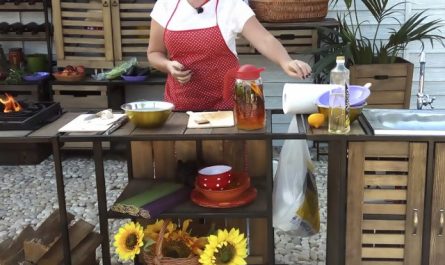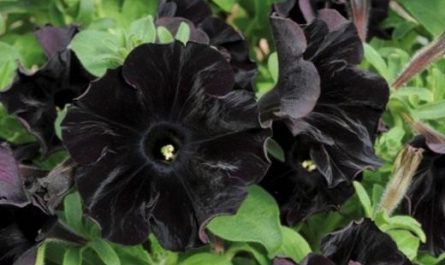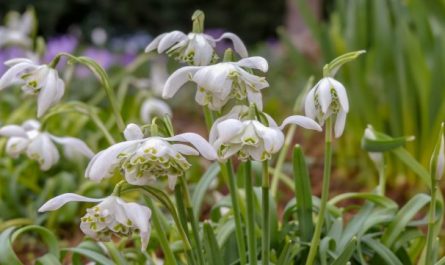Passionate gardeners always enjoy visiting nurseries of collectors. Botanical gardens are one thing, they mostly have ornamental plants. Fruit nurseries are another, they are purely commercial. But collectors are especially interesting. In addition to some basic collectible culture, they drag to themselves all the interesting and unusual: fruit, berry, vegetable, ornamental, medicinal, spicy and aromatic…

And not only can you see a lot of interesting things, but they will also tell you about everything, show you, let you touch, smell and try! I went to the sweet potato farm to the Lutsany and saw so many things! But now – about the decorative sweet potato, which was the initial goal of the trip.
Ornamental morning glory sweet potato
Sweet potato (Ipomoea batatas) belongs to the genus Ipomoea in the Convolvulaceae family. It has pretty gramophone-shaped flowers typical of Convolvulaceae. It is a distant relative of the Ipomoea tricolor, which is prohibited for cultivation. Legitimate.
But the decorative varieties of sweet potato are siblings to the food variety. The only difference is in their purpose. Like parsley: there are root vegetables and leaf vegetables. And so it is here.

Unlike most morning glory species grown for their spectacular blooms, ornamental sweet potatoes are good primarily for their foliage. Ornamental sweet potatoes have enviable foliage: dense, leathery, glossy, resistant to fungal diseases and “too tough” for many leaf-eating pests. Considering the plant’s resistance to heat, drought, and rain, you won’t find a better option for stable decorativeness.

We liked the ornamental sweet potato not only for its stability and overall cheerful appearance, but also for its ability to densely cover the soil, mulching itself and preventing weed growth.
It is worth noting that plenty of sun and average humidity are preferable to shade and dampness for most varieties of sweet potato. In the sun, the color becomes as bright as possible, the plant develops much better. Many varieties get along well with each other, shading, complementing or creating contrasts. The bright underside of the leaves of some varieties adds piquancy to the compositions. The most stunning combinations are lime-colored foliage with dark purple. Leaves of different shapes – from triangular to pinnate give wide scope for imagination.
You can form dense, bright, and even flowering “green walls” from the shoots of decorative sweet potatoes. It works best on a garden plastic mesh – a fence, thick and strong with large cells. Sweet potato morning glory shoots will not climb up voluntarily, you will have to fix them regularly. But the appearance of the multi-colored “wall” is enchanting. Varieties with shoots up to 2 m are suitable for these purposes.
2 in 1: delicious and beautiful varieties of sweet potatoes
2-in-1 options are always attractive. Sweet potato varieties that can be grown in a flowerbed, admired all summer, and in the fall, you can dig up edible tubers from them – just a godsend.
“Kelly Rae”
To date, Vitaly and Natalia Lutsany have identified one new variety that produces elongated root tubers with white skin and light flesh – “Kelly Rae” (Ipomoea batatas ‘Kelly Ray’). A variegated variety with large, wide, heart-shaped leaves.

The main color of the leaf is burgundy-violet with green inclusions of different shapes and sizes. The plant is powerful, the vines are up to 2 m, strong, not brittle. When forming a “green wall” it is convenient to attach to a support. Does not bloom. In this variety, in the shade, the green inclusions become larger and more saturated, which is not surprising. For photosynthesis in the shade, more chloroplasts are required, and they are green. The plant increases the proportion of green areas due to the purple pigment.

“Face of an Angel”
Another variety, this time a signature one, was developed by the Lutsanov family (they also do selection!) — “Face of an Angel”. Obtained from open pollination of the variety “Sweet Caroline Purple” (’Sweet Caroline Purple’).
Differs from the original variety in leaf shape, color, tasty commercial tubers, and abundance of flowering. It has been monitored for several years, and its characteristics are stable. “Angel’s Face” blooms abundantly and willingly with light pink gramophone-shaped flowers, and grows vines up to two meters.

Features of care
Tuberous varieties do not have any special requirements for growing. Everything is the same as everyone else: moderately fertile soil, uniform watering (they do not like either prolonged soaking or overdrying), moderate fertilizing.
Sweet potato morning glory loves warmth and will develop most actively when summer temperatures set in and the soil warms up. In regions with short summers, it is advisable to grow it in containers, pots, hanging baskets. Or on raised flower beds, which is preferable for the formation of full-fledged tubers.
The Kelly Ray variety, when propagated by tubers, produces shoots with single-colored, not variegated, leaves. So it is better not to risk it, but to take cuttings of the plant and keep it on the windowsill over the winter. Eat the tubers – they are delicious both baked and fried. And they give soups a special exquisite taste.
It is very likely that after tasting the ornamental sweet potato tubers, you will want to grow large, differently tasty sweet potato tubers.
New trends – what to choose from
By color
The first significant parameter is color. Copper color has been added to the main common colors, reddish, purple, bronze and lime. Variety — “Sweet Caroline Copper” (Ipomoea batatas ‘Sweet Caroline Copper’). Young and mature leaves have different shades, which makes the plant especially decorative.

There are already quite a few variegated varieties, but the trait is preserved only when propagated by cuttings. And it strongly depends on lighting. Combinations of purple and green are more common, as in the variety “Kelly Rae”. Three-color coloring, as in the variety “Pink Frost” (Ipomoea batatas ‘Pink Frost’) is noticeably rarer.

By form
The second parameter is the shape of the leaf. It can be heart-shaped or lobed, as in the variety “Sweet Caroline Bronze” (Ipomoea batatas ‘Sweet Caroline Bronze’). Or it may be strongly dissected into lobes, as in the varieties “Face of an Angel” or “Sweet Caroline Medusa Green” (Ipomoea batatas ‘Sweet Caroline Medusa Green’). The leaf lobes can be from 3 to 7. And all sorts of transitional variants. New – variety “Rusty Maple Lay” (‘Rusty Maple Leaf’) – with leaves resembling maple.

By size
The third parameter is the size of the plant. There are long-vine varieties with unbranched shoots up to 2 m. And there are moderately vine varieties up to 1 m. Very compact varieties have already been bred, for example, the variety “Flora Mio Nero” (Ipomoea batatas ‘FloraMia Nero’), which forms bushes up to 30 cm in diameter and also blooms profusely.
Flowering of sweet potato morning glory is a bonus, since not all varieties bloom. They are tropical, they have nowhere to rush, and then, before you know it, it’s winter.
In general, the variety of varieties is already such that you can choose one for any taste and to solve a wide variety of design problems.
How to Grow Sweet Potato Morning Glory
Cultivation of sweet potato morning glory has its own subtleties – it reproduces almost exclusively vegetatively. That is, at the end of summer, in August, the shoots are cut into cuttings, take root, planted in containers and live indoors throughout the cold season. They grow weakly during the winter, and become active with the onset of spring. At this time, cuttings are cut from the plant, take root, and they will be the planting material.
Many varieties of morning glory sweet potato do not form tubers at all. At least in the Russian climate. As the Lutsans say, they have never seen tubers in the line of varieties «Sweet Carolina» и “Illusion Midnight Lace” (Ipomoea batatas ‘Illusion Midbight Lace’). Tricolor ‘Pink Frost’ with green foliage adorned with pink and cream splashes produces tubers. They are small and are best eaten. The sprouts from the tubers produce plants with pure green leaves.
Even those sweet potatoes that grow small tubers on their roots are best propagated by cuttings. Small tubers are difficult to preserve in winter because sweet potatoes are stored in warmth and dryness, and small tubers dry out in these conditions.
The propagation features also dictate the timing of the acquisition of seedlings: either in the fall or in the spring. Both options have their pros and cons. Autumn rooted cuttings will require a warm and very light place on the windowsill, regular treatments during the winter (they are very prone to breed spider mites), but in the spring, as they grow, you can cut a lot of cuttings. Spring seedlings will cost more, but for those who are categorically short of space on the windowsills, this is a good option.


















